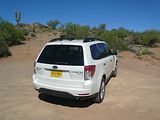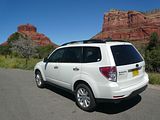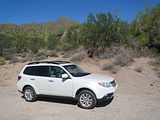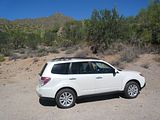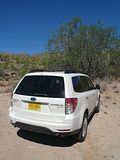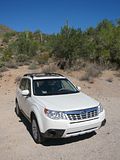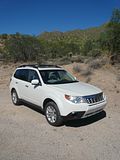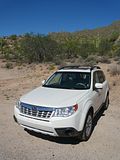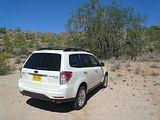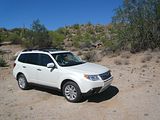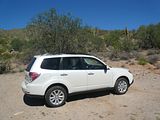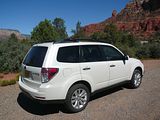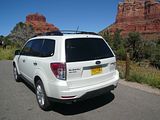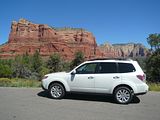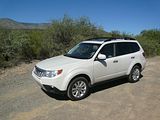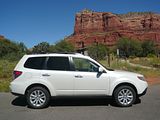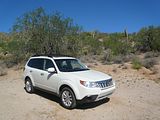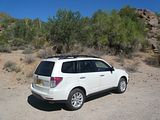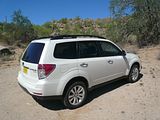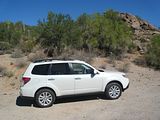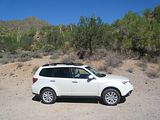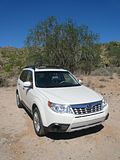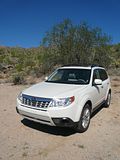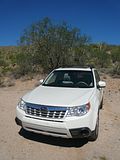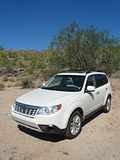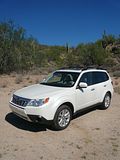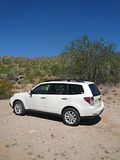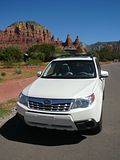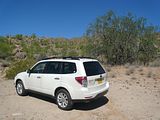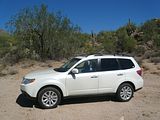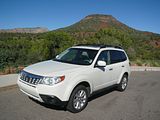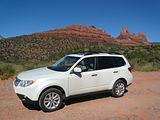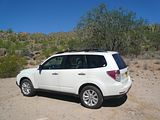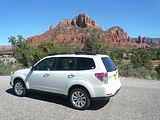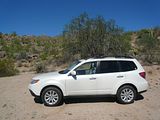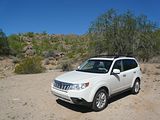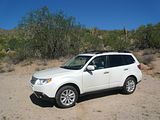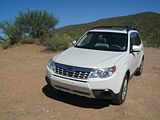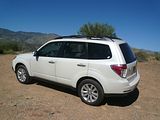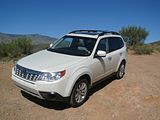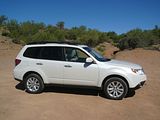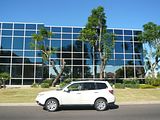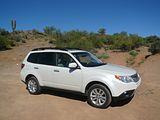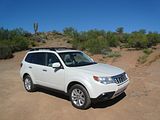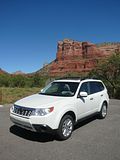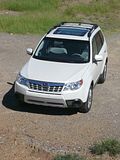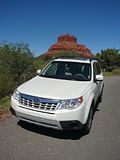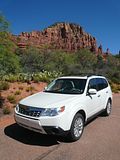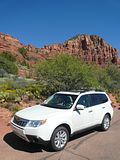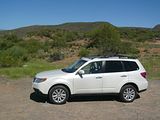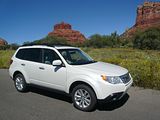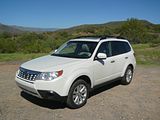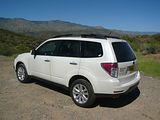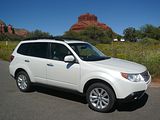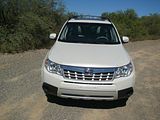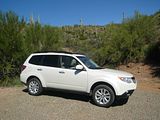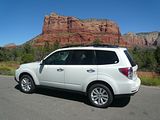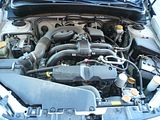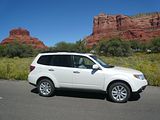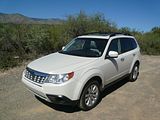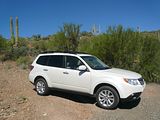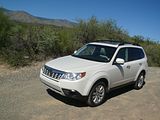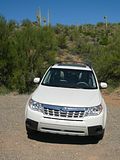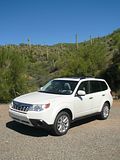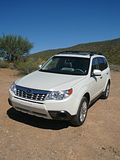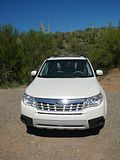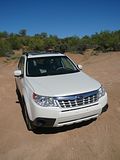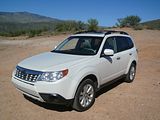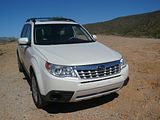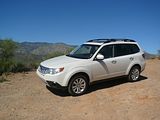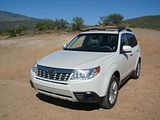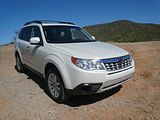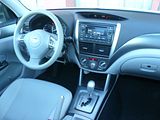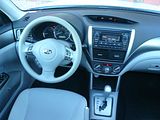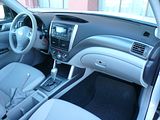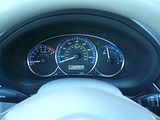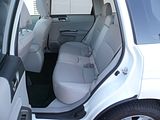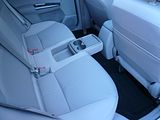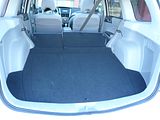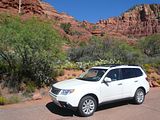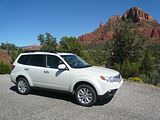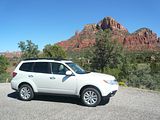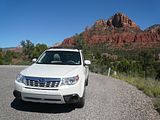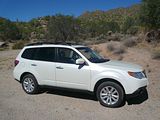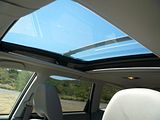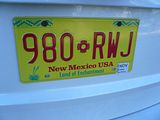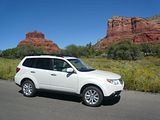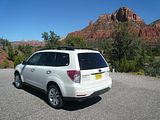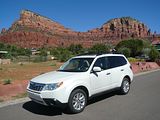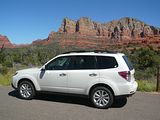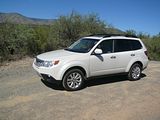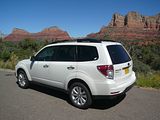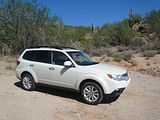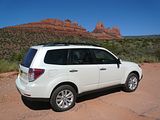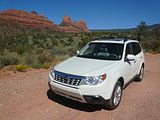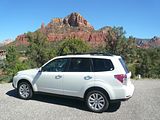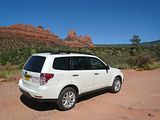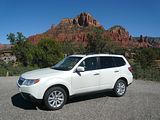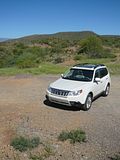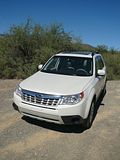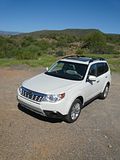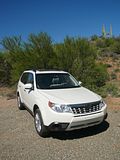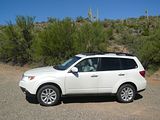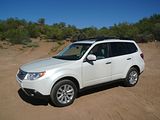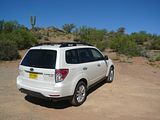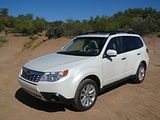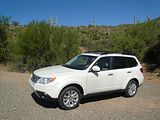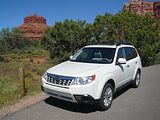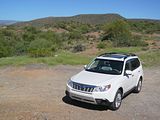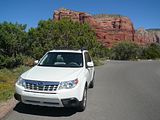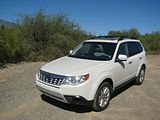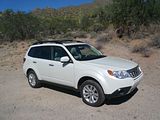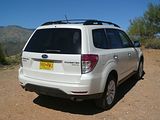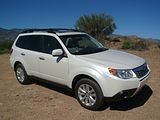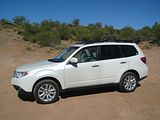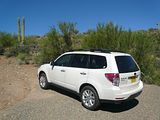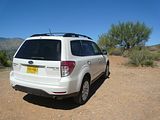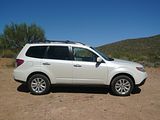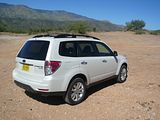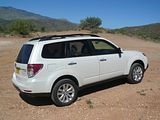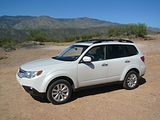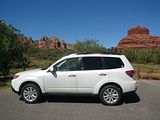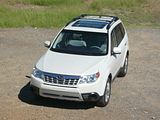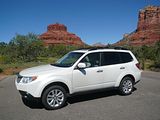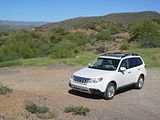Tuesday evening: the nadir of rental car availability at most US airport locations. It certainly seemed that way at Hertz’ huge Phoenix’s Sky Harbor location when I walked over from the returns area to collect my next vehicle. All I could see in all directions appeared to be just the odd car and an awful lot of empty spaces. As I approached the Gold Service booth, it was clear that there were a few more cars parked up around it, but there was evidently not going to be much choice. I was a little early, so my name was not yet showing on the board, which meant that a car had not been allocated, so after a quick look around, I went to go and see what they could offer, not optimistic of getting anything that was on my still rather long list of cars I have yet to sample. The reservation was for a “Small SUV”, but the initial offer was for a Chevy Traverse or GMC Acadia, neither of which are exactly small. However, as further proof that if you don’t ask, you don’t get, I had spotted one car on that walk around, and wondered if I would be allowed it. It had been there when I had arrived in Phoenix a few days earlier, but in a different bay, and with a Post-It note on the driver’s window which said “please clean up, and then rent out one way to California”. Now it had been moved, and the Post-It note was gone, presumably as when car supply was this short, Hertz needed it to fulfil a reservation whether or not it was going to leave the State. That car was the outgoing model Subaru Forester, which I had already moved on my spreadsheet of “Cars to Drive” from the “current” page to the “obsolete” page, assuming that they were all gone from Hertz’ fleet and the opportunity had been missed. A quick consultation behind the scenes and the counter rep returned to tell me that I could have it.
With Subaru sales everywhere in Europe apart from the small Swiss market dwindled to more or less negligible – and one look at the styling of each new model should give us the first clue why that might be, as they get uglier and uglier – Subaru have declared that their future focus will be back to how they started out, as a maker of practical, relatively affordable vehicles with all-wheel drive making them suitable for use in difficult terrain and countries blessed with severe winter weather. That means that while the enthusiasts are still lamenting the end of the exciting rally-derived WRX and STi models, we can expect a stronger focus on cars like the Forester. Indeed, this one machine sums up what Subaru now say they will sell. In Europe, that is. In America, of course, things are different, and here total brand sales continue to increase, so it is clear that the challenging looks are no impediment to commercial success. There is another difference, which is that whilst almost all European Subaru sales are now of diesel engined models, America’s almost complete and total antipathy to the derv powered car – largely perpetuated by ill-informed nonsense and hysteria promulgated by the media – means that all US model Subarus are petrol powered, often with different engines from those offered to the rest of the world. Most of the US market Subarus are built in America, too, though the designs are the same as are offered elsewhere in the world. In the US market, the Forester is outsold quite convincingly by the Outback (76, 000 units last year compared to 117,000 for the Outback), both of which are a lot higher than what was achieved by the Legacy Saloon and the unloved Tribeca. So, it is an important car, and one with plenty of competition, from the likes of the big selling Toyota RAV4, Ford Escape and Honda CR-V, as well as VW’s Tiguan, Mazda’s much lauded new CX5 and the Korean duo of Hyundai Tucson and Kia Sportage. Would the traditional Subaru strengths shine and impress me, or would this prove to be like the last Subaru model I drove, a Legacy, which was all rather too bland for its own good?
With their characteristic sounding flat four engines, not only did every previous Subaru sound unlike almost any other car on the road, but they tended to feel that bit special when you drove one, too. Although the boxer unit remains, the unique noise has been silenced so much that at least from inside the car, you would not know that this is a different engine type from the usual in-line four. Sadly, the driving experience has also been rather anaesthetised. There was nothing wrong with the way the Forester drove, but even while I had the test car, I wrote the word “unmemorable” on my note pad. And that’s a pity. Standard engine in the US market Forester is the 4 cylinder PZEV (Partial Zero Emission Vehicle) 2.5 litre petrol engine that also features in the US Impreza, the Legacy and the Outback. It puts out 170 bhp, and in the test car was coupled to the optional four speed automatic gearbox. Whilst it works quite smoothly, it became very apparent that a transmission with another ratio or two would help matters, as the Forester’s engine was spinning at over 3000 rpm at just 60 mph, and that took its toll on economy. On the first day I had the Subaru, I quickly became alarmed at the rate at which the fuel gauge seemed to be dropping from Full. Initially I wonder if this was because it had been “rental car full”, but the drop continued, so that by the time I had driven 100 miles, the needle was showing little more than half full. And it was not as if I had been particularly brutal with the car, unless you count the long climb on I17 north Phoenix as a really hard test (it’s not that steep!). Later in the day, the decline in apparent fuel level did seem to abate somewhat, and my concern that the range was going to be less than 250 miles proved invalid. When I handed the car back and did the calculations, average fuel economy came to 26.2 mpg US, which equals 31.4 mpg Imperial.
Clutching that rather nasty plastic steering wheel, I quickly found out that the steering is at least better than the rival Toyota product, as there is some feel and some weight to it, but this is no sports car. And that impression continues with the handling, too, which is safe but utterly predictable, perhaps a consequence of the standard all wheel drive system. The flat four may have a lower centre of gravity than in-line engines, but once you put an SUV style body around it, some of the advantage is clearly lost, and that felt to be the case here. There is not much body roll, but you are unlikely to be tackling the corners with any real gusto in the first place. The suspension set up is such that at least the Forester rides quite nicely. Unlike some of its competitors, which are more about looks than real capability, the Forester is designed to tackle more than just tarmac, and whereas I did not take onto anywhere more challenging than photographic locations, I understand that you could head onto the dirt, or the snow or sand and that the Forester would acquit itself well, thanks to good ground clearance as well as the symmetrical AWD set up. The brake pedal had a rather mushy feel at the start of travel, but get past this and the biting point was obvious and the anchors themselves seemed to work fine. A centrally mounted pull-up handbrake is fitted between the seats. With a large glass area, and a relatively vertical rear end, all round visibility was good and judging the extremities was easy.
Every Subaru seems to have a better quality interior than the last, but at the risk of damning with faint praise, it’s not just Subaru whose standards have been improving in recent years, so they tend still to look lower rent than those found in the opposition. That’s certainly the case for this Forester. The overall effect is probably not helped by the light beige very obviously plastic steering wheel, but then when you look at the dashboard, whilst everything fits together quite snugly, it is clear that it is made of a series of cheap and hard plastics. Various different colours are used, with a dark upper surface, and lighter shades lower down, which ultimately colour match the beige colour of the upholstery. The same is true of the door casings. The dashboard itself scores quite highly for being user-friendly, though, as it is not afflicted by countless and pointless switches and buttons. The main instruments are presented in a nest of three dials under a single curved cowl. A central speedometer has a rev counter to the left and a large dial with just a fuel gauge to the right. Indication of water temperature is done by a warning light, which illuminates blue when you start the Forester up from cold and which goes out pretty quickly. The dials are easy to read and clearly marked. Twin column stalks, with indicators and lights on the left and wipers on the right cover most of what you need frequently. The audio unit is set high in the centre of the dash, above the central air vents. It is a relatively simple unit, which promised satellite radio, but when I pressed the button, nothing happened, not even an indication that the subscription had expired. Below this are the three rotary dials for the air conditioning system. Above all this in a slightly eliptical opening is an area where the outside temperature and digital clock are displayed. There are small and rather fiddly buttons on the steering wheel hub for the cruise control and to repeat some audio functions.
Subaru position the Forester as more practical vehicle than the Legacy Outback, so you expect it have more space inside for people and things, and indeed it does. The squared off styling means that within its relatively compact dimensions, there is ample room for the average sized family and their luggage. The rear seats are relatively upright, and thanks also to the taller SUV-style body, there is lots of headroom. There’s plenty of legroom too and the Forester is wide enough that three adults could just about fit across the width of the car without feeling too squashed. Behind them is a good sized boot, nice and regular in shape and quite deep from the boot floor to the window line. There is more space available under the boot floor, as there is a moulding which sits on top of the spare wheel, giving several stowage areas for small and relatively flat items. Need more space, then you can fold down the rear seat backrests. They are split asymmetrically, and simply drop onto the rear seat cushions, giving a flat luggage area. Annoyingly, the central seat belt is fed from the roof and so this remains in situ when the seat is folded down and would get in the way of larger objects. There is plenty of oddments space in the cabin, too, with a modest glove box and door pockets on all four doors augmented by a deep cubby under the central armrest as well as two moulded unlidded areas alongside the handbrake and a further area in front of the gearlever. There is a map pocket on the back of only the front passenger seat. A flip up and over part of the centre of the rear seat cushion reveals a pair of cup holders for the occupants of the back seats to use. The Forester also has built in roof rails, which as well as contributing to the look of the car would allow you to strap extra stuff to the roof.
US market Foresters are available in 4 trim levels: X, Premium, Limited and Touring. There is also the option of the more powerful turbo-charged 2.5 litre engine which gives you another 54 bhp. Priced at $22,495 with the optional automatic gearbox, the entry level X models are not exactly luxurious, though they do cover the main essentials in a family SUV, with air conditioning, cruise control, an AM/FM radio unit with CD, MP3 and AUX capabilities the most notable items, The test car was a Premium, which costs $24,795 on the road and includes an electrically adjustable driver’s seat and a huge glass sun roof to the equipment tally. Add another $2200 for a Limited and you get a leather wrapped steering wheel, heated mirrors, automated climate control, The top spec Touring adds a back-up camera and the climate control operates in dual zone mode.
With the exception of the outmoded 4 speed automatic gearbox, and the rather disappointing fuel economy, the Forester was a perfectly pleasant car. But far more than was the case when the first model to bear the name appeared in 1997, it competes in a crowded marketplace, with plenty of very capable rivals, so it needs to be more than just “perfectly pleasant”. At the start of the test, I pondered whether the Forester would display enough of the traditional Subaru character and charisma or whether it had gone the way of the current Legacy and in a quest for conformity had lost its unique defining attributes. The answer, as probably became clear in about the third paragraph of this report, sadly, is very clearly “the latter”. There was nothing really wrong with the Forester. Indeed, it is a practical car, with plenty of space, and likely to prove reliable and dependable for a long time. But nor did it have any particularly compelling advantage over any of its rivals. It really does seem that Subaru have diluted the things that used to make them special, and whilst objectively that might give a “better” product, it will not necessarily appeal to those who used to be the marque’s biggest fans. And that is probably why sales in Europe have been virtually extinguished. Subaru was always a niche choice, but now that it has no real USP, and plenty of rivals trying to offer something similar, there is nothing to be gained from buying from the niche, so the majority of purchasers will look elsewhere, to a brand with more dealers, more publicity and probably more aggressive sales deals. That sales have increased steadily in America, a nation where the utterly bland appliances from Toyota have such a stranglehold on the sales charts just shows that for the vast majority of US buyers, they really don’t want anything that deviates from the mainstream. That means that we can expect future Subaru models are ever more likely to be developed with these consumers in mind. The days of the exciting and the different Subaru would appear to be gone for good. Or rather, for bad. What a shame.


